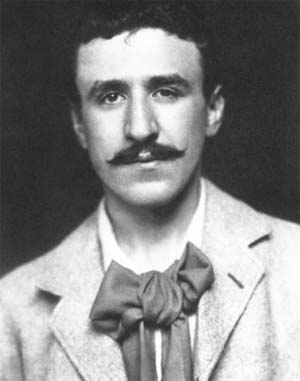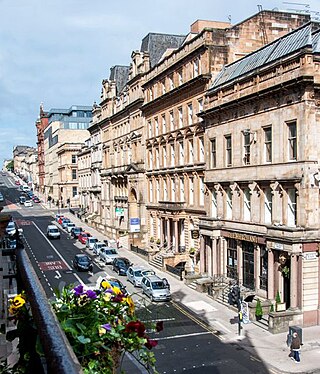
Charles Rennie Mackintosh was a Scottish architect, designer, water colourist and artist. His artistic approach had much in common with European Symbolism. His work, alongside that of his wife Margaret Macdonald, was influential on European design movements such as Art Nouveau and Secessionism and praised by great modernists such as Josef Hoffmann. Mackintosh was born in Glasgow and died in London. He is among the most important figures of Modern Style.

Glasgow is the most populous city in Scotland, and is the third-most populous city in the United Kingdom, as well as being the 27th largest city by population in Europe. In 2022, it had an estimated population as a defined locality of 632,350 and anchored an urban settlement of 1,028,220. Formed as a county of itself in 1893, the city had previously been in the historic county of Lanarkshire and has also grown to include settlements that were once part of Renfrewshire and Dunbartonshire. It now forms the Glasgow City Council area, one of the 32 council areas of Scotland, and is administered by Glasgow City Council.

Burning Man is a week-long large-scale desert event focused on "community, art, self-expression, and self-reliance" held annually in the western United States. The event's name comes from its culminating ceremony: the symbolic burning of a large wooden effigy, referred to as the Man, that occurs on the penultimate night, the Saturday evening before Labor Day. Since 1991, the event has been at Black Rock City in northwestern Nevada, a temporary city erected in the Black Rock Desert about 100 miles (160 km) north-northeast of Reno. According to Burning Man co-founder Larry Harvey in 2004, the event is guided by ten stated principles: radical inclusion, gifting, decommodification, radical self-reliance, radical self-expression, communal effort, civic responsibility, leaving no trace, participation, and immediacy.

Buchanan Street is one of the main shopping thoroughfares in Glasgow, the largest city in Scotland. It forms the central stretch of Glasgow's famous shopping district with a generally more upmarket range of shops than the neighbouring streets: Argyle Street, and Sauchiehall Street.
Garnethill is a predominantly residential area of the city of Glasgow, Scotland with a number of important public buildings.

The McLellan Galleries are a major exhibition space in the city of Glasgow, Scotland, situated behind a frontage of shops and offices in Sauchiehall Street.

James Gillespie Graham was a Scottish architect, prominent in the early 19th century.

The Merchant City, a new name introduced through urban renewal by the Scottish Development Agency and the city council in the 1980s is one part of the metropolitan central area of Glasgow. It commences at George Square and goes eastwards reaching Glasgow Cross, in the centre of Glasgow, Scotland. The eastern fringe of the Merchant City contains part of Glasgow's original medieval street plan, which stretches northwards towards neighbouring Townhead.
Lieutenant-Colonel Archibald Campbell, 1st Baron Blythswood, was a Scottish soldier, Tory politician, scientist and Grand Master of the Grand Lodge of Scotland.

Blythswood Hill, crowned by Blythswood Square, is the wealthiest part of central Glasgow, Scotland. It extends from the west edge of Buchanan Street to Gordon Street and Bothwell Street, Charing Cross, Sauchiehall Street and Garnethill. Developed from 1800 onwards, its Georgian and Victorian architecture is a Conservation Area. It started as the "Magnificent New Town of Blythswood" becoming a part of the city-centre's business and social life.

Sauchiehall Street is one of the main shopping streets in the city centre of Glasgow, Scotland, along with Buchanan Street and Argyle Street.

The Willow Tearooms are tearooms at 217 Sauchiehall Street, Glasgow, Scotland, designed by internationally renowned architect Charles Rennie Mackintosh, which opened for business in October 1903. They quickly gained enormous popularity, and are the most famous of the many Glasgow tearooms that opened in the late 19th and early 20th century. The building was fully restored, largely to Mackintosh's original designs, between 2014 and 2018. It was re-opened as working tea rooms in July 2018 and trades under the name "Mackintosh at The Willow". This follows a trademark dispute with the former operator of The Willow Tearooms which was resolved in 2017. This name is now used at tea room premises in Buchanan Street and was also additionally used at the Watt Brothers Department Store in Sauchiehall Street, Glasgow between 2016 and its closure in 2019.

Baron Blythswood, of Blythswood in the County of Renfrew, was a title in the Peerage of the United Kingdom. It was created on 24 August 1892 for Sir Archibald Campbell, 1st Baronet, the former Member of Parliament for Renfrew, with remainder failing heirs male of his own to five of his younger brothers and the heirs male of their bodies.
Pride Scotia is Scotland's national LGBT pride festival. Since 1995, volunteers have organised a Pride March and a community-based festival in June, alternating between the cities of Edinburgh and Glasgow.

Blythswood House was a 100-room neoclassical mansion at Renfrew, Scotland, built for the Douglas-Campbell family from the considerable incomes arising from their ownership of the Lands of Blythswood in Glasgow, including Blythswood Hill, developed initially by William Harley of Blythswood Square, and earlier lands surrounding Renfrew and Inchinnan.
Blythswood Football Club was a 19th-century football club based in Glasgow.

The Glasgow Society of Lady Artists was founded in 1882 by eight female students of the Glasgow School of Art with the aim of affording due recognition to women in the field of art. It has been described by Jude Burkhauser as "the first residential club in Scotland run by and for women". In the early days of the club, they met at 136 Wellington Street, Glasgow.
Glasgow City Centre is the central business district of Glasgow, Scotland. Is bounded by Saltmarket, High Street and Castle Street to the east, The River Clyde to the south and the M8 motorway to its west and north. Glasgow City Centre is composed of the areas of Garnethill, Blythswood Hill and Merchant City as well as parts of Cowcaddens, Townhead, Anderston and Calton.

St. Vincent Street, is one of the major streets in the city centre of Glasgow, Scotland. It was formed in the early 1800s as part of the residential New Town of Blythswood developed by William Harley of Blythswood Square. St. Vincent Street was named to commemorate the victory of Sir John Jervis, on 15 February 1797, off Cape Saint Vincent, Portugal. when the Royal Navy defeated the Spanish fleet which was on its way to join Napoleon's French fleet.

Blythswood Square is the Georgian square on Blythswood Hill in the heart of the City of Glasgow, Scotland. The square is part of the 'Magnificent New Town of Blythswood' built in the 1800s on the rising empty ground west of a very new Buchanan Street. These open grounds were part of the vast Lands of Blythswood stretching to the River Kelvin acquired by the Douglas-Campbell family in the 17th century. The Blythswood district became a Conservation Area in 1970, because of its important architectural and historic buildings.















